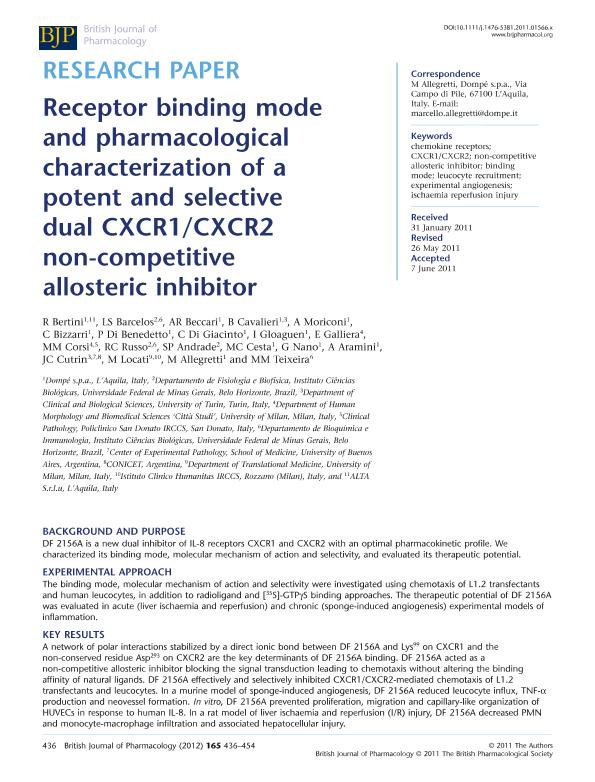Artículo
Receptor binding mode and pharmacological characterization of a potent and selective dual CXCR1/CXCR2 non-competitive allosteric inhibitor
Bertini, R.; Barcelos, L. S.; Beccari, A. R.; Cavalieri, B.; Moriconi, A.; Bizzarri, C.; Di Benedetto, P.; Di Giacinto, C.; Gloaguen, I.; Galliera, E.; Corsi, M. M.; Russo, R. C.; Andrade, S. P.; Cesta, M. C.; Nano, G.; Aramini, A.; Cutrin, Juan Carlos ; Locati, M.; Allegretti, M.; Teixeira, M. M.
; Locati, M.; Allegretti, M.; Teixeira, M. M.
 ; Locati, M.; Allegretti, M.; Teixeira, M. M.
; Locati, M.; Allegretti, M.; Teixeira, M. M.
Fecha de publicación:
01/2012
Editorial:
Wiley Blackwell Publishing, Inc
Revista:
British Journal of Pharmacology
ISSN:
0007-1188
Idioma:
Inglés
Tipo de recurso:
Artículo publicado
Clasificación temática:
Resumen
Background and Purpose: DF 2156A is a new dual inhibitor of IL-8 receptors CXCR1 and CXCR2 with an optimal pharmacokinetic profile. We characterized its binding mode, molecular mechanism of action and selectivity, and evaluated its therapeutic potential. Experimental Approach: The binding mode, molecular mechanism of action and selectivity were investigated using chemotaxis of L1.2 transfectants and human leucocytes, in addition to radioligand and [ 35S]-GTPγS binding approaches. The therapeutic potential of DF 2156A was evaluated in acute (liver ischaemia and reperfusion) and chronic (sponge-induced angiogenesis) experimental models of inflammation. Key Results: A network of polar interactions stabilized by a direct ionic bond between DF 2156A and Lys99 on CXCR1 and the non-conserved residue Asp 293 on CXCR2 are the key determinants of DF 2156A binding. DF 2156A acted as a non-competitive allosteric inhibitor blocking the signal transduction leading to chemotaxis without altering the binding affinity of natural ligands. DF 2156A effectively and selectively inhibited CXCR1/CXCR2-mediated chemotaxis of L1.2 transfectants and leucocytes. In a murine model of sponge-induced angiogenesis, DF 2156A reduced leucocyte influx, TNF-α production and neovessel formation. In vitro, DF 2156A prevented proliferation, migration and capillary-like organization of HUVECs in response to human IL-8. In a rat model of liver ischaemia and reperfusion (I/R) injury, DF 2156A decreased PMN and monocyte-macrophage infiltration and associated hepatocellular injury. Conclusion and Implications: DF 2156A is a non-competitive allosteric inhibitor of both IL-8 receptors CXCR1 and CXCR2. It prevented experimental angiogenesis and hepatic I/R injury in vivo and, therefore, has therapeutic potential for acute and chronic inflammatory diseases.
Archivos asociados
Licencia
Identificadores
Colecciones
Articulos(ININCA)
Articulos de INST.DE INVEST.CARDIOLOGICAS (I)
Articulos de INST.DE INVEST.CARDIOLOGICAS (I)
Citación
Bertini, R.; Barcelos, L. S.; Beccari, A. R.; Cavalieri, B.; Moriconi, A.; et al.; Receptor binding mode and pharmacological characterization of a potent and selective dual CXCR1/CXCR2 non-competitive allosteric inhibitor; Wiley Blackwell Publishing, Inc; British Journal of Pharmacology; 165; 2; 1-2012; 436-454
Compartir
Altmétricas



